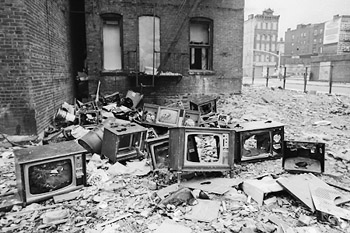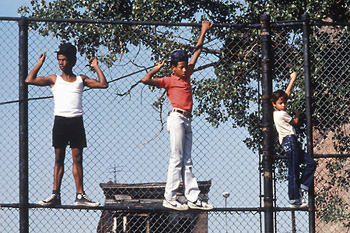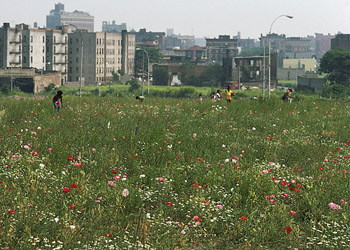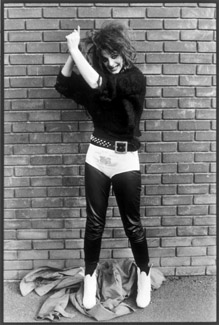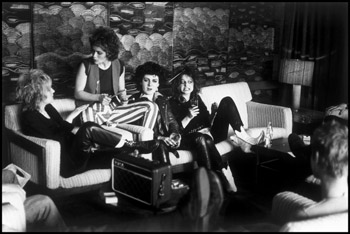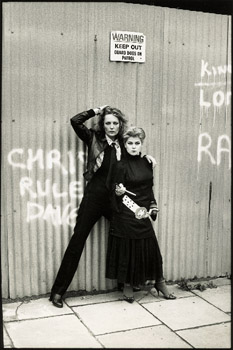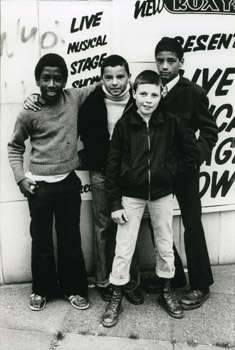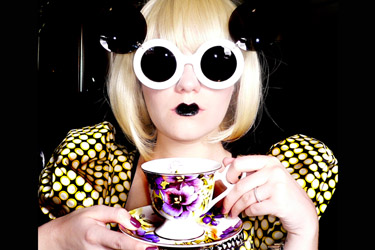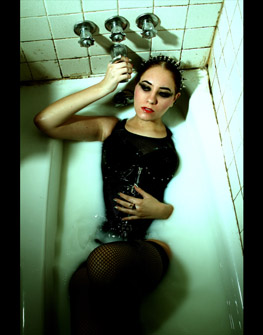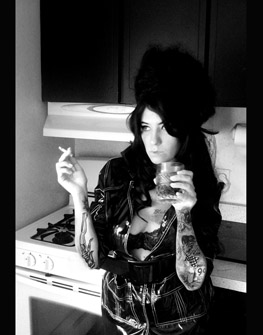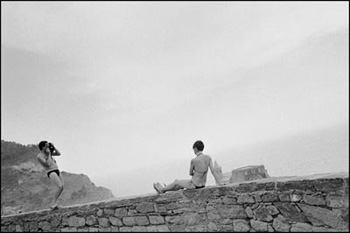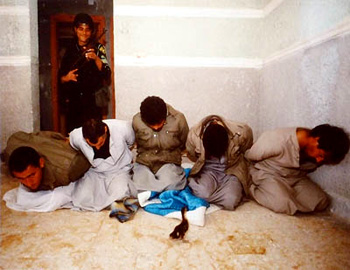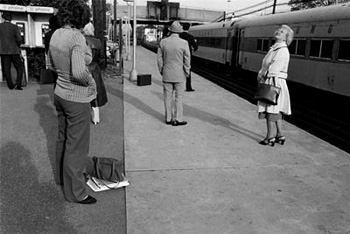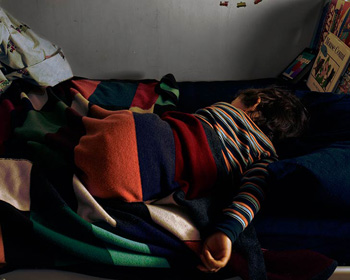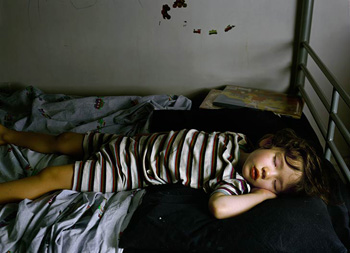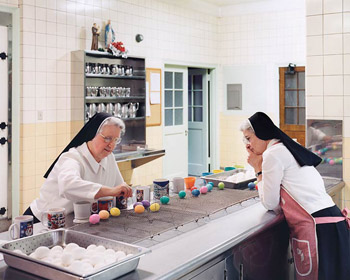Tag Archives: 30 x 30
30 By 30: Lisa Kahane / Jill Freedman
30 Women Photographers and the Women Photographers Who Inspired Them
A Blog Series in Honor of Women’s History Month, March 1 – 31
Lisa Kahane is a professional photographer specializing in portraiture and documentary work. Her images have appeared in magazines and newspapers worldwide, including The New York Times, New York Daily News, Philadelphia Inquirer, and Artforum. They have also been featured in many books, including her own Do Not Give Way To Evil: Photographs of the South Bronx 1979-1987.
In addition to solo shows, her work has been featured in exhibits at the Bronx Museum, The Museum of the City of New York, and was included in documentation for The American Century at The Whitney. Her images are in the permanent collections of the New York Public Library, the Fales Library at New York University, and the Library of Congress. Some are on view now in Occupy Wall Street at the South Street Seaport Museum, and in April will be in This Side of Paradise at the Andrew Freedman Home.
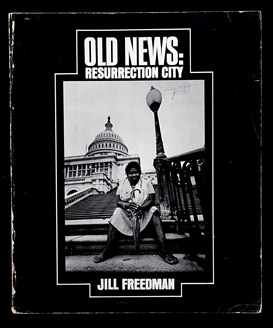
Photograph of Jill Freedman's book "Old News: Resurrection City" (Grossman Publishers, New York, 1970)
Can you talk a bit about the woman photographer who inspired you most?
LK: It’s June, 1968. An African American woman sits alone on the steps leading to the Capitol in Washington, DC. Her expression mixes anger, disappointment and resignation. Her presence dominates the government building in the distance behind her. She’s looking directly into the camera.
I remember seeing this black and white photograph, bordered by columns of text, on the editorial page of a newspaper. The credit line appears adjacent to the image-Jill Freedman. The physical presence of the woman in the photograph and the presence of a woman’s name in the credit line both had a visceral effect on me. I remember it clearly. The picture was alive with emotion. It was the first important photograph I saw that was taken and published by a woman.
As a teenager, I watched the civil rights movement on the nightly news. When Dr. King was assassinated in April ’68, I watched Harlem burn from my apartment on Morningside Drive. Three weeks later, my friends and classmates occupied buildings on the Columbia campus, effectively shutting down the university. It was overwhelming. I took a few pictures. At the beginning of June, Robert Kennedy was assassinated.
Jill Freedman’s response to the turbulent political situation was more definitive. She quit her job and marched to Washington with the Poor People’s Campaign that Dr. King had planned. She spent six weeks living in the encampment next to the mall, photographing and writing about daily life in this temporary city. Her pictures were published in the June 28th issue of Life Magazine. In 1970, Grossman Publishers brought out her first book, Old News: Resurrection City. The woman on the Capitol steps is the cover and the last page of the book.
Since then, Jill has published six books about people whose lives frame our culture but whose names rarely make the news. She’s traveled with the circus, lived with firemen fighting the flames of the South Bronx in the 70s, and ridden along with police on the Lower East Side and Times Square during violent days and nights.
Biographies of women photographers often describe their education, their supportive families and staff, their influential mentors. I value these women. but their stories seem remote from my own. Jill taught herself photography and did her own darkroom work. At a time when few women were working in photojournalism, she did it anyway. She’s survived changing fashion and fortune. She speaks plainly and passionately. Her work is about people and circumstances. Her belief in photography’s power to educate is undiminished. “If you show it,” she says, “people see will see what’s wrong.”
I’ve researched the editorial page where I first saw Jill’s work – I can’t find it. The more I learn about Jill, however, the more she inspires me.
What is the role of a professional documentary photographer today as opposed to someone who happens to be on the spot with a camera phone?
LK: Good question! Everyone’s a critic. These days everyone’s a photographer also. I suspect a surfeit of images has blunted our perception, making good enough, good enough. When someone with a cell phone camera blocks my shot or complains I’m in their way, the joke goes sour fast. When the police pepper spray a peaceful protest, video from a cell phone camera is a very effective witness. With every gain, there’s a loss.
Berenice Abbott said “Photography helps people to see.” Did she mean the practice or the appreciation of photography?
_____________________________________
Jill Freedman is a legendary, self-taught documentary photographer. Her gritty images of New York street life and people living at the edge of society are in the Museum of Modern Art, the International Center of Photography, and the Smithsonian, and her many books include the classics Old News: Resurrection City, Circus Days and Street Cops.
Facing serious illness in the late 1980′s, Freedman disengaged from photography and New York, but eventually made her way back. She is currently putting together a website and working on a new book about the city in the 60′s, 70′s, and 80′s, when it was, as she says, “still New York.€
In a phone conversation this week, Ms. Freedman said that in 1968, she “wasn’t even a photographer” when she took the picture on the Capitol steps. “I was very angry and quit my job and went down. It was a moment of history I wanted to shoot.€
The Poor People’s Campaign was organized in 1967 by Martin Luther King, Jr. and the Southern Christian Leadership Conference to address economic inequity. After Dr. King was assassinated on April 14, 1968, the leaders decided to go ahead with the campaign in his honor.
In mid-May, demonstrators began to protest in Washington, D.C., and thousands of poor people set up makeshift dwellings known as “Resurrection City.€ It was shut down in mid-June, the hoped for economic bill of rights never realized. But if the voices raised in protest and hope have faded, the pictures Freedman took will endure as a lasting record of that time.
For a narrated slide show on Freedman’s coverage of this event, visit NPR.
- Catherine Kirkpatrick, Archives Director
______________________________
30 By 30 blog series:
Intro: Dianora Niccolini / Women of Vision
Lauren Fleishman / Nan Goldin
Darleen Rubin / Louise Dahl-Wolfe
Dannielle Hayes / Diane Arbus
Meryl Meisler / Via Wynroth
Shana Schnur / Louise Dahl-Wolfe
Claudia Kunin / Imogen Cunningham
Gigi Stoll / Flo Fox
Robbie Kaye / Abi Hodes
Alice Sachs Zimet / Lisette Model
Juliana Sohn / Sally Mann
Susan May Tell / Lilo Raymond
Nora Kobrenik / Cindy Sherman
Caroline Coon / Ida Kar
Lisa Kahane / Jill Freedman
Karen Smul / Dorothea Lange
Claudia Sohrens / Martha Rosler
Laine Wyatt / Diane Arbus
Ruth Fremson / Strength From the Many
Greer Muldowney / Lee Miller
Rachel Barrett / Vera Lutter
Aline Smithson / Brigitte Lacombe
Ann George / Josephine Sacabo
Judi Bommarito / Mary Ellen Mark
Kay Kenny / Judy Dater
Editta Sherman / The Natural
Patt Blue / Ruth Orkin
Vicki Goldberg / Margaret Bourke-White
Beth Schiffer / Carrie Mae Weems
Anonymous / Her Mother
30 By 30: Caroline Coon / Ida Kar
30 Women Photographers and the Women Photographers Who Inspired Them
A Blog Series in Honor of Women’s History Month, March 1 – 31
Caroline Coon is a multi-talented artist born and based in Britain. She is a painter, designer and photographer whose work has been exhibited at major London galleries, including the Saatchi Gallery and the Tate. Her photographs are in the National Portrait Gallery, and currently on display at the Strand Gallery in She-Bop-a-Lula, an exhibit celebrating female singers captured by women photographers.
In the 1970′s and 80′s, Coon wrote about, designed for, and photographed a number of Punk Rock bands, including The Slits and The Clash. Her New Wave Punk Rock Explosion is an inside, “as it happened” story of punk, with iconic images, and commentary by musicians and fans.
Which woman photographer inspired you most?
CC: The woman photographer I’d like to spotlight from a cluster of creative women who inspired me in my early twenties is Ida Kar. Photography was central to my life as a fine art student in the mid 1960′s because it was widely feared that this mechanical, fast image making would be the death of painting. Since I was a painter I hoped painting would survive, but never the less I was fascinated by photography especially when I discovered that heroes like Degas and Toulouse-Lautrec used photography as a sketch aid to their painting almost from the moment the camera was invented.
As a teenager at art school, with few women students and not one women tutor, I felt very isolated. I needed examples of creative women to identify with. Then, one day walking through Soho with an older male artist friend of mine, he said to me: ‘That’s Ida Kar’s studio!’ My ignorance made me blush, but the name stuck in my mind and my heart leapt when shortly thereafter I saw Ida Kar as name credit in a magazine against a portrait of Bridget Rilley. Here was the photographer as artist making a woman artist the subject of her work. Perfect!
When did you become aware of her and what did she enable you to do?
CC: At art school in the 1960′s none of the creative women who had been exemplary in various avant garde movements were ‘taught’. In fact women were erased from the canon once these movements were written up by what we now call “white male gatekeepers.” Discovering women like Ida Kar gave me my psychological backbone. I thought it was outrageous that no tutor, not in any department, had told us students about, say, Madame Yevonde or Tina Modotti or Dorothea Lange. I searched out information about these women, aided by the feminist movement’s revalation of all the ‘buried’ creative woman of the past who knocked down the sexist lie that there had never been nor could there ever be great women artists.
Women like Ida Kar were crucial to me, not so much in their creative styles as the way they lived, and despite obstruction and rejection, they were determined to be professional artists creating remarkable bodies of work. Whenever my confidence has failed me, it has been the example of women like Ida Kar who have given me the strength to survive and continue.
You note that there were very few women photographers in the 60s and 70s. Can you tell a bit about what it was like breaking into the “old boys€ club?
CC: No, No, No, correction! It is not me but others who talk about there being ‘few female’ photographers. I am always at pains to point out that considering the socio-political restrictions that women existed under in the past it is heroic how very many women photographers there were! Just because these woman are not ‘taught’ or generally known doesn’t mean they did not/do not exist.
And no, I did not ‘break into the “old boys€ club’. Firstly, in honor of all women in the past who have struggled politically to give me all the legal rights that I now enjoy, I have always called myself a feminist. The notice Feminists Not Allowed is nailed above the door of the ‘old boys club’. Secondly, standing outside and working outside a boys club is a useful strategy because in the long run such exclusionary clubs become redundant!
How is it different today for women photographers? Are the barriers more subtle?
CC: One of the great triumphs for women over the last fifty years has been the right to earn money and be professional. As a teenager (with an upper class background) it was drummed into me that it was ‘not lady-like’ for women to work or earn money and even if I did, I would have to give it all up when I got married. Perhaps this is why, when I was thirteen, I confided to my diary that I would never get married!
I’ve learned many lessons from professional men-especially what it takes to maintain a position in the work place. If there are barriers for women today, and there are, then they are mainly psychological. A lot depends on how prepared a woman is to be competitive, ambitions, determined, self-serving, selfish, pushy and egotistic. Despite all the professional advances women have made today, sometimes women still find it difficult to feel as equally entitled as men to fight for work and recognition.
Do you feel that women photographers bring a special and different perspective to their work?
CC: No, I do not subscribe to the theory that ‘women photographers’ bring a special and different perspective to their work. ‘Women’ is not a genre! Women are individuals and just as likely as men to be hard and forensic – look at Letizia Battaglia’s photographs of the Mafia or Lee Miller’s war photographs. Men are just as likely as women to be soft and empathic – look at Ken Heyman’s photographs of nursing mothers or Robert Mapplethorpe’s photography of flowers.
At times and in places when woman were not/are not allowed into the public space then we should not be surprised that their subjects are ‘domestic’.
Over the years when I have been outside sketching or photographing I have become practiced in a careful riposte to men who take it upon themselves to come up to me and say: You shouldn’t be out here alone – aren’t you afraid of being raped?
________________________________
Ida Kar was born in Russia in 1908, educated in Egypt, then traveled to Paris where she began photography. She married Edmond Belali and together they began a photo studio in Cairo. It was there that she met surrealist artist and poet, Victor Musgrave. They married in 1944, and in 1945 moved to London, where Kar began advertising as a theatrical photographer. Musgrave managed, and later owned a space called Gallery One. Together they became part of London’s post-war art scene.
Kar photographed many famous literary and art world personalities of the time, as well as people she encountered on the London streets. Her landmark exhibition at the Whitechapel Art Gallery in 1960 was the first one-person photography show to be held in a major London gallery. It marked the highpoint of her fame, and sparked debate in Britain over what exactly could be considered as photographic art.
In the late 1950′s, Kar travelled abroad, including trips to Armenia, East Germany and Cuba. She also photographed the famous of Britain, though by the late 60′s, her business had begun to wane. She died in 1974 in her Bayswater bedsit.
In 1999, Britain’s National Portrait Gallery purchased Kar’s archive, and in 2011, presented a major exhibit of her work.
- Catherine Kirkpatrick, Archives Director
______________________________
30 By 30 blog series:
Intro: Dianora Niccolini / Women of Vision
Lauren Fleishman / Nan Goldin
Darleen Rubin / Louise Dahl-Wolfe
Dannielle Hayes / Diane Arbus
Meryl Meisler / Via Wynroth
Shana Schnur / Louise Dahl-Wolfe
Claudia Kunin / Imogen Cunningham
Gigi Stoll / Flo Fox
Robbie Kaye / Abi Hodes
Alice Sachs Zimet / Lisette Model
Juliana Sohn / Sally Mann
Susan May Tell / Lilo Raymond
Nora Kobrenik / Cindy Sherman
Caroline Coon / Ida Kar
Lisa Kahane / Jill Freedman
Karen Smul / Dorothea Lange
Claudia Sohrens / Martha Rosler
Laine Wyatt / Diane Arbus
Ruth Fremson / Strength From the Many
Greer Muldowney / Lee Miller
Rachel Barrett / Vera Lutter
Aline Smithson / Brigitte Lacombe
Ann George / Josephine Sacabo
Judi Bommarito / Mary Ellen Mark
Kay Kenny / Judy Dater
Editta Sherman / The Natural
Patt Blue / Ruth Orkin
Vicki Goldberg / Margaret Bourke-White
Beth Schiffer / Carrie Mae Weems
Anonymous / Her Mother
30 By 30: Nora Kobrenik / Cindy Sherman
30 Women Photographers and the Women Photographers Who Inspired Them
A Blog Series in Honor of Women’s History Month, March 1 – 31
Nora Kobrenik was born in Odessa, Ukraine, and moved to United States when she was twelve. She has a B.A. in Fine Art from the School of Visual Arts, and received a Robert Mapplethorpe Foundation Award upon graduating for a body of work that “embodied originality and courage.€
Kobrenik works as a Visuals Coordinator at Uptempo Magazine, recruiting young and talented photographers for publication. She splits her time between Connecticut and New York City.
Which woman photographer inspired you most?
NK: Cindy Sherman. What inspired me most was her ability to transform herself into a completely different character photograph after photograph. I also found it fascinating that she almost always works alone. She is her own make up artist, wardrobe mistress, photographer, art director and model. I work in a very similar manner-more often than not I am alone. It’s also interesting that she uses herself as a major tool in telling the story of her characters. She’s not afraid to appear too sexual or too ugly. I also found it very inspiring that she used her art as therapy, although she often denies it.
When did you become aware of her and what did she enable you to do?
NK: I have first learned of Cindy Sherman when I wrote a paper on her for a high school photography class. We had to find an artist whose work was similar to our own and it seemed like a perfect match since I have always been drawn to self-portraiture. She enabled me to stand up for my art and what I wanted to do in my work. Year after year, professors and mentors tried to steer me away from self-portraits, to get me to turn the camera on anybody and anything but myself. But like Sherman, I don’t see my work as self-portraits. Those women aren’t me. They are characters that represent different things in different moments, and it just so happens that only I can portray them.
Some of your images are bold, others more subdued with hints of violence. Can you comment on this?
NK: Every image has a different thought process, a different inspiration. Most of my inspiration comes from music and song lyrics. Some are brighter and bolder; others are darker and come from an entirely different place, a place that is uglier and more violent. My work tends to deal with female seduction, power, sexuality, femininity, sex, and fear of seduction. I am very interested in the way that sex is power. You can hold it over someone’s head, you can play with them, and you can get your way. I’m not interested portraying a weak woman. All these ideas combine in the creation of my images.
Can you talk about the experience of women in Russia as opposed to the United States?
NK: Women are strong creatures in any country, be it the United States or Russia. Currently the environment in Russia and all the former Soviet Union countries is the same as the United States. The feminist movement has reached far and wide.
As a young photographer, have you faced any resistance in the field?
NK: Personally I have never felt oppressed or faced resistance being a woman in this field. I think that my predecessors in the 70s and 80s broke through the invisible fence that separated men and women in the art fields for good. Overall, I’ve had a rather good experience-let’s hope it continues this way!
Any advice to women photographers today?
NK: Work hard. You can’t go places without doing the legwork. Listen to advice from your mentors, but always follow your heart and your own instincts. And remember that for one person who doesn’t like your work, there will be ten who will love it.
_____________________________________
Cindy Sherman a photographer and film director known for her photographic series and conceptual portraits. Born in Glen Ridge, New Jersey, in 1954, she studied painting at Buffalo State College, but switched to photography because she felt it allowed her to concentrate more on ideas.
In 1977, Sherman began a series of sixty-nine 8×10 B&W photographs called Untitled Film Stills, using herself as the model. Drawing on the look and feel of publicity shots and clips from noir movies, these are less self-portraits than comments on gender, identity, and cultural perception. The Museum of Modern Art purchased the entire series in 1995, the same year Sherman was awarded a Catherine T. MacArthur Foundation Award.
Other series include: Rear-Screen Projections, Centerfolds, Fairy Tales and Disasters, History Portraits and Sex Pictures. Her work has appeared in major exhibitions around the world, and is currently featured in a major exhibit at the Museum of Modern Art.
- Catherine Kirkpatrick, Archives Director
______________________________
30 By 30 blog series:
Intro: Dianora Niccolini / Women of Vision
Lauren Fleishman / Nan Goldin
Darleen Rubin / Louise Dahl-Wolfe
Dannielle Hayes / Diane Arbus
Meryl Meisler / Via Wynroth
Shana Schnur / Louise Dahl-Wolfe
Claudia Kunin / Imogen Cunningham
Gigi Stoll / Flo Fox
Robbie Kaye / Abi Hodes
Alice Sachs Zimet / Lisette Model
Juliana Sohn / Sally Mann
Susan May Tell / Lilo Raymond
Nora Kobrenik / Cindy Sherman
Caroline Coon / Ida Kar
Lisa Kahane / Jill Freedman
Karen Smul / Dorothea Lange
Claudia Sohrens / Martha Rosler
Laine Wyatt / Diane Arbus
Ruth Fremson / Strength From the Many
Greer Muldowney / Lee Miller
Rachel Barrett / Vera Lutter
Aline Smithson / Brigitte Lacombe
Ann George / Josephine Sacabo
Judi Bommarito / Mary Ellen Mark
Kay Kenny / Judy Dater
Editta Sherman / The Natural
Patt Blue / Ruth Orkin
Vicki Goldberg / Margaret Bourke-White
Beth Schiffer / Carrie Mae Weems
Anonymous / Her Mother
30 by 30: Susan May Tell / Lilo Raymond
30 Women Photographers and the Women Photographers Who Inspired Them
A Blog Series in Honor of Women’s History Month, March 1 – 31
Susan May Tell is an award-winning fine art photographer whose work has been showcased in solo exhibitions at the Museum of Art | Fort Lauderdale; the Griffin Museum of Photography; the University of California at San Francisco; and the Avenue B Gallery. Solo exhibitions include A Requiem: tribute to the spiritual space at Auschwitz; Structured Moments; and Real / Unreal: urban landscapes of the 1980′s.
Tell’s photographs are in the Smithsonian’s Samuel Wagstaff Collection, and have been featured in group exhibitions at the Monmouth Museum; the Phoenix Art Museum; and the Barrett Art Center, where Malcolm Daniel, Curator in Charge of the Department of Photographs at the Metropolitan Museum of Art, awarded her First Place. In 2010, Nat Trotman, Associate Curator of Art, Guggenheim Museum of Art, included her work in two exhibitions he juried at that same venue.
Also a successful photojournalist, Tell spent four years based in Cairo and four years in Paris working for the New York Times, LIFE, TIME, and Newsweek Magazines. This was followed by ten years as a staff photographer and photo editor at the New York Post.
Tell’s subjects have been diverse and include: a 9-month project with Egypt’s drug enforcement agency; the women fighters of the Eritrean People’s Liberation Front; Iraqi Kurdish refugees in Turkey; Islamic and Pharaonic Monuments in Egypt; the National Basketball Association Finals; lunch with Yasser Arafat and his entourage in Kuwait; murders; car accidents; perp walks; stake-outs; actors; hot air ballooning; 3-star restaurants and 5-star hotels.
Which woman photographer inspired you most?
SMT: Many women photographers inspire me. However, I feel a special connection to Lilo Raymond-for her art and the memorable impact a meeting with her had on my life.
First, her art. Lilo’s brilliance was her ability to focus her camera on the most ordinary objects and imbue them with feeling: a bed with rumpled white sheets and white pillows, somewhat askew. What is the magic that takes a scene, so mundane, and transforms its present, its presence, literally shown, into a metaphor? A story that conjures the past and raises questions about its meaning, its future? And how is it that we believe these used sheets, in a bare room, have personal meaning or memory, and make ‘us,’ the viewers, care?
Although I first saw that particular image decades ago, it is recreated in my mind’s eye as quickly as one can say “Lilo.” Her images are spare, minimal, exquisitely yet subtly framed, and share with poetry the “economy of language.”
About that memorable meeting. It was September, 1982. At the time I was busy creating personal work, getting exhibitions, was being considered for a New York State Photography Fellowship. The Photography Department of the School of Visual Arts hosted a registration evening. Meet a few instructors, speak with them a few moments, show them your portfolio, maybe they convince you to sign up for their course. Instead Lilo suggested that I go to my local newspaper and submit my work. Had she not suggested I could work as a photographer, I might never have even considered it. She believed I was ready to go out into the world-and so I did!
I approached a local paper, The Villager. I photographed Friday nights and Saturdays, developed film and made prints on Sundays, and on Monday morning, on my way to my real job, slid my prints under their door. They paid $6 for each published photo.
Six weeks later, my solo exhibition People Alone opened in New York City. With prints from that exhibition, plus the tear sheets from The Villager, the New York Times gave me my 1st assignment.
How did you feel?
SMT: For me, it was the start of a beautiful adventure. Meant to be. A ‘zen’ thing. Lots of responsibility. Before I had only to satisfy myself when I pressed that shutter button, now I felt compelled to satisfy the client, do justice to the subject/story- AND continue to satisfy my artistic self all at the same time. A new challenge. Huge challenge. I enjoy challenges.
______________________________
Lilo Raymond was born in Frankfurt, Germany, in 1922. Fleeing the Nazis, she came to New York in the late 1930s, and supported herself with different jobs. In her late thirties, she began studying photography with David Vestal at the Photo League. A few years later she began to accept commercial jobs and exhibit her fine art images, most of which were spare, black and white, and taken in natural light.
In a 2008 interview with Beth E. Wilson, Raymond said: “I was always centering in on very simple things, like a vase of flowers…. I think what I do is that I stare at something, and then it invites me to take a picture.€
Books featuring Raymond’s images include: Revealing Light: Photographs; Linens and Lace; and Simple Wisdom: €¨Shaker Sayings, Poems, and Songs. Her work is in many collections, including the Museum of Modern Art, the Metropolitan Museum of Art, and the Victoria and Albert Museum, and in 2008 was featured in a retrospective at the Samuel Dorsky Museum of Art at SUNY New Paltz. That year Raymond also received the Vision Award from the Center for Photography at Woodstock.
- Catherine Kirkpatrick, Archives Director
______________________________
30 By 30 blog series:
Intro: Dianora Niccolini / Women of Vision
Lauren Fleishman / Nan Goldin
Darleen Rubin / Louise Dahl-Wolfe
Dannielle Hayes / Diane Arbus
Meryl Meisler / Via Wynroth
Shana Schnur / Louise Dahl-Wolfe
Claudia Kunin / Imogen Cunningham
Gigi Stoll / Flo Fox
Robbie Kaye / Abi Hodes
Alice Sachs Zimet / Lisette Model
Juliana Sohn / Sally Mann
Susan May Tell / Lilo Raymond
Nora Kobrenik / Cindy Sherman
Caroline Coon / Ida Kar
Lisa Kahane / Jill Freedman
Karen Smul / Dorothea Lange
Claudia Sohrens / Martha Rosler
Laine Wyatt / Diane Arbus
Ruth Fremson / Strength From the Many
Greer Muldowney / Lee Miller
Rachel Barrett / Vera Lutter
Aline Smithson / Brigitte Lacombe
Ann George / Josephine Sacabo
Judi Bommarito / Mary Ellen Mark
Kay Kenny / Judy Dater
Editta Sherman / The Natural
Patt Blue / Ruth Orkin
Vicki Goldberg / Margaret Bourke-White
Beth Schiffer / Carrie Mae Weems
Anonymous / Her Mother
30 By 30: Juliana Sohn / Sally Mann
30 Women Photographers and the Women Photographers Who Inspired Them
A Blog Series in Honor of Women’s History Month, March 1 – 31
Juliana Sohn is a professional and fine art photographer based in New York. Her photographs have been published in Time, New York Magazine, Martha Stewart Living, and Real Simple Magazine. She is the mother of two boys who appear in her photographs.
Which woman photographer inspired most?
I learned about Sally Mann during a mandatory photo history class in art school. Her book At Twelve was mentioned one day in class, and I remember going to the school library to look it up, sitting in the stalls mesmerized and engrossed by the work. The images were evocative, strong and beautiful. They were full of content and said all sorts of things.
There was an overwhelmingly popular belief in my photo classes that what was important in a photo was content, that content trumped craft and form. I was a strong believer that a photo could and should possess both content and form. I believed that an image should be beautiful or engaging enough to look at, otherwise you couldn’t hold the viewers interest long enough for them to want to learn about the content.
Mann’s work showcased both. While At Twelve was my first exposure to Sally Mann’s work, the body of work I most admire of hers is Immediate Family, which I strongly believe is one of the most important series of work produced by an artist. It’s hard to describe the force these images have. They lure you in with their lush beauty and tantalizing sexuality. The complexity of the relationships, the stories these photos tell about family, life, youth, and co-dependency is remarkable. That she is not just documenting her family, but has a seamless hand in directing and guiding the images make the photos incredibly complicated for me. The way I like to work best-long term projects where you get to know the person and/or develop the idea-is very similar to the way Mann probably works. I start my projects with the intention of discovering something, not to tell a specific tale of something I already know.
There have been some interesting coincidences that I’d like to share.
My senior thesis in college consisted of heavily scripted imagery and I was always searching for people to be in my photos. One of the girls in At Twelve had an older sister who was also a student at my school and a good friend of a friend. Both sisters appeared in At Twelve, the younger sister more prominently. They were lovely, perfect for some of my scripts. I was fortuitous enough to have both ladies pose for me for my thesis project. Of course I was thrilled to have that small connection to Sally Mann in my work.
A couple of years after I graduated from school I received a phone call from Anna Gaskell, an acquaintance I had taken photo classes with while we were both studying abroad our junior year. She had assisted Sally Mann, and was reaching out to see if I might be interested in replacing her. At the time, I was working as an assistant to New York fashion photographers, and could not see how to transition to living with the Mann family in rural Virginia. As much as I longed for that once in a lifetime experience, I knew that the job would entail 100% commitment and support of someone else’s life. I was not willing to give up my newly found freedom from parents and school, and I did not follow up on this inquiry.
I looked through Immediate Family for the first time in over a decade, and am still awed by the power of these images. I look forward to spending some time with them again, this time seeing the pictures from a mother’s viewpoint. It is with a bit of chagrin that I am reminded that Sally Mann’s son is named Emmett, as is my five year old son, same spelling and all.
Your images seem very intimate. Does your personal life and gender affect the pictures you take?
I am a petite, small-framed woman. Perhaps this helps in getting people to trust me; I’m not threatening. I think I am good at getting people to relax because I am honestly interested in who they are and listen earnestly to their responses. I think my strength is in seeing uniqueness in others that they discount or don’t notice. I am good at asking many, many questions to get to the answers that I find useful and revealing for the portrait, not just settling for the information they want to immediately tell me.
Advice for woman photographers?
Keep your clothes on. You have so much more to offer than nude photos of yourself.
___________________________________________
Sally Mann was born in 1951 in Lexington, Virginia, and began photography at The Putney School in Vermont. After earning an B.A. and an M.A. from Hollins College, she embarked on a landmark photographic career. Her third book, Immediate Family, published in 1992, created controversy for its intimate, somber view of her young children, who were often featured in the nude.
Using large format cameras and historic processes, Mann has created many exquisite and personal bodies of work featuring her own family and the landscape of the American South. She is Guggenheim fellow and three-time recipient of the National Endowment for the Arts fellowship. Her photographs are in many private and public collections, including the Metropolitan Museum of Art, the Museum of Modern Art, and the Whitney Museum of American Art. She is represented by Gagosian Gallery in New York.
- Catherine Kirkpatrick, Archives Director
______________________________
30 By 30 blog series:


